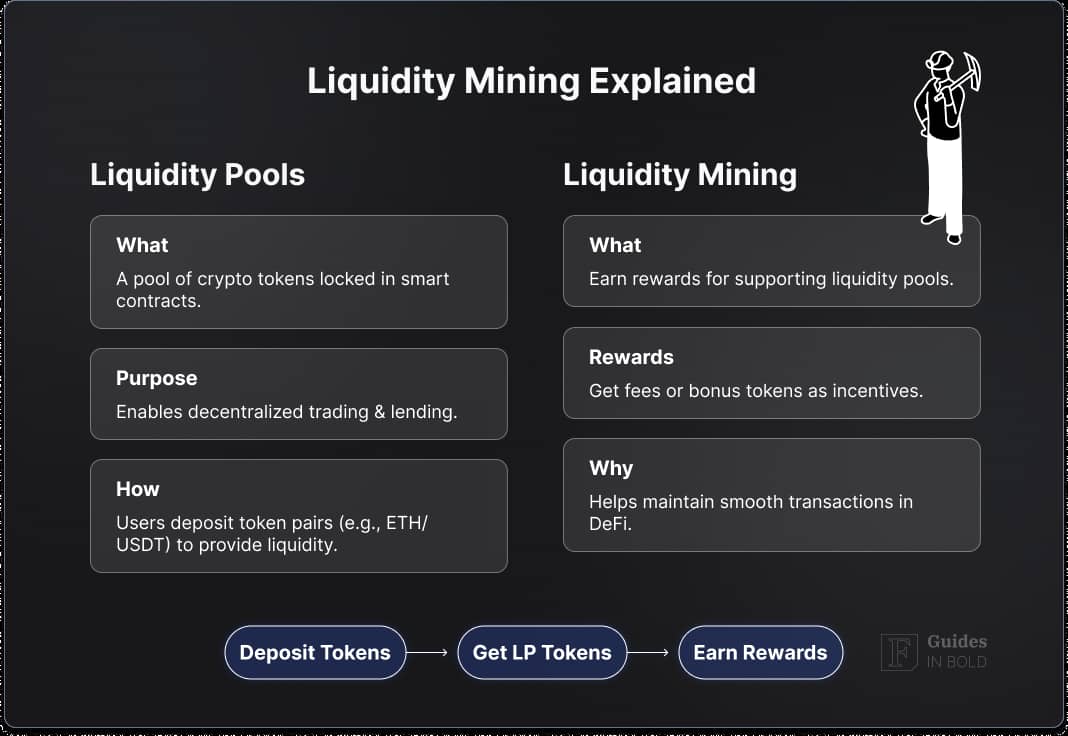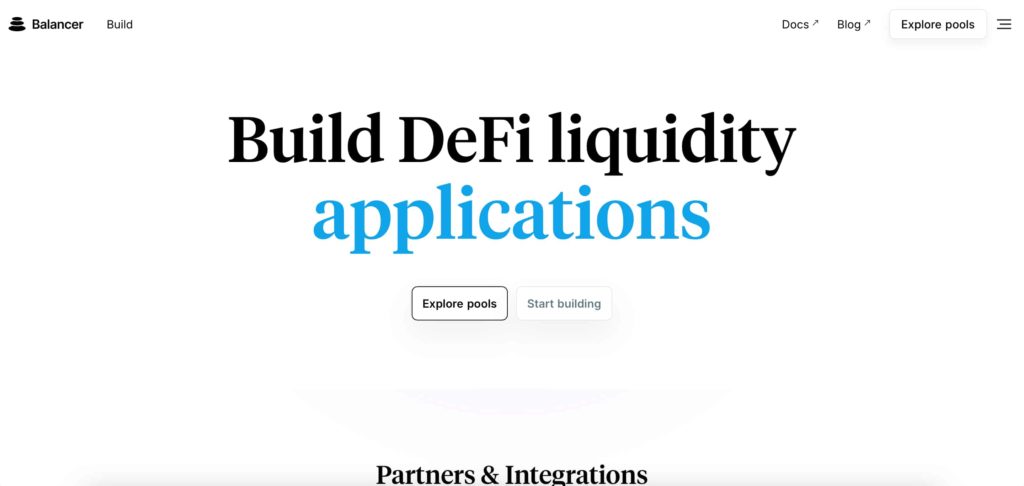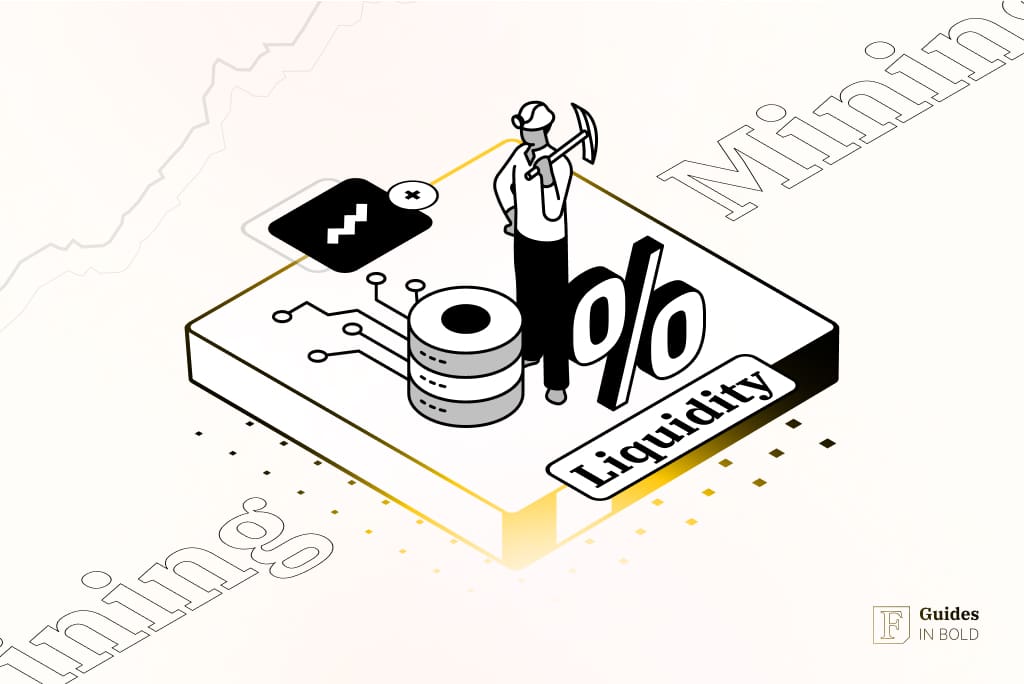IMPORTANT NOTICE
Finbold may provide educational material to inform its users about crypto and digital assets. This content is for general information only and does not constitute professional advice or training certification. Content is provided "as is" without any warranties. Users must conduct their own independent research, seek professional advice before making investment decisions, and remain solely responsible for their actions and decisions.
RISK WARNING: Cryptocurrencies are high-risk investments and you should not expect to be protected if something goes wrong. Don’t invest unless you’re prepared to lose all the money you invest.
By accessing this Site, you acknowledge that you understand these risks and that Finbold bears no responsibility for any losses, damages, or consequences resulting from your use of the Site or reliance on its content. Click here to learn more.
One of the most popular applications of blockchain technology is decentralized finance (DeFi), and a popular way for crypto investors to participate in DeFi is to mine for liquidity. In this guide, we will introduce the concept of DeFi liquidity mining, explain why it matters, see what platforms enable users to mine for liquidity, and go over its benefits and the risks involved in this investment strategy.
Best Crypto Exchange for Intermediate Traders and Investors
-
Invest in cryptocurrencies and 3,000+ other assets including stocks and precious metals.
-
0% commission on stocks - buy in bulk or just a fraction from as little as $10. Other fees apply. For more information, visit etoro.com/trading/fees.
-
Copy top-performing traders in real time, automatically.
-
eToro USA is registered with FINRA for securities trading.
Introduction to DeFi and Liquidity Mining
Earning passive income is one of the best ways to invest in cryptocurrencies. There are several ways to do that, including:
- Decentralized finance is a new fintech application that seeks to disrupt traditional financial markets using decentralized networks such as blockchains. DeFi platforms work by eliminating centralized financial intermediaries allowing market participants to interact in a peer-to-peer (P2P) manner;
- Yield farming is a broad categorization for all methods used by investors to earn passive income for lending out their cryptocurrencies. They can receive interest, a portion of fees accrued on the platform they are lending their tokens or new tokens issued by these platforms;
- Liquidity mining is one of the more common ways of yield farming where investors can earn a steady stream of passive income. In this guide, we will discuss what it is, including the risks and benefits to investors engaging in the practice. Not only that, but we also highlight some of the best liquidity mining platforms for anyone looking to make use of their packed crypto.

What Is Liquidity Mining?
Definition
The term liquidity means the ease with which an asset can be converted into spendable cash. In other words, the easier it is for an asset to be spent, the more liquid it is. Mining, on the other hand, is a sort of a misnomer in this situation that refers to the more common way of getting rewarded in Proof of Work (PoW) networks such as Bitcoin for contributing towards verifying transactions.
However, the use of the term mining in this title alludes to the idea that these liquidity providers (LPs) are looking for some rewards – fees and/or tokens – for their efforts.
Recommended video: What is a liquidity pool in crypto?
Crypto beginners’ corner:
- How to Invest in Crypto? Complete Beginner’s Guide
- Best Cryptocurrency Exchanges – Top 7 Picks
- 15 Best Crypto Books for Beginners
- Must-read Crypto Wallets Guide for Beginners
- How to Mint & Sell NFTs? Beginner’s Guide
- How to Stake Cryptocurrency? Step-by-Step
- 11 Crypto Slang Terms Explained
- Best Crypto Trading Bots – Top 3 Picks
Yield Farming vs. Staking vs. Liquidity Mining
All three methods – staking, yield farming, and liquidity mining – are just ways to put investor’s crypto-assets to use and earn a passive income.
- Staking is an overarching category of all activities and different ways to earn rewards from owning certain cryptocurrencies. Its main intent is to keep the blockchain network secure by authenticating blockchain transactions;
- Yield farming, on the other hand, is a broad categorization of methods used by crypto traders and investors to earn compensation in the form of annual percentage yield (APY) via lending out their cryptocurrencies, as they can get interest or new tokens;
- So, it brings us to liquidity mining, which is one of the common ways of yield farming. Liquidity mining is where investors aim to earn passive income through supplying liquidity to decentralized exchanges (DEX’s) DeFi protocols.
How Does Liquidity Mining Work
Participating in these liquidity pools (LPs) is very simple as it involves depositing your assets into a common pool called a liquidity pool. The process is similar to sending cryptocurrency from one wallet to another. A liquidity pool typically consists of a trading pair such as ETH/USDT. As a liquidity miner (or provider), an investor could opt to deposit either asset into the pool.
By depositing their assets into the Defi platforms, the LPs make it easier for traders to get into and out of positions with the trading fees partly used to reward them.
The more an LP contributes towards a liquidity pool, the larger the share of the rewards they will receive. Different platforms have varying implementations, but this is the basic idea behind liquidity mining.

Key Terms and Concepts (Explained)
To effectively participate in a DeFi protocol as a liquidity provider, there are terms and concepts with contextual meaning that you will need to be aware of and understand. Some of them include:
- DEX – this is a short form for decentralized exchange, which is a platform that runs autonomously without direct intervention from a centralized party such as a company. DeXes are trading platforms to which liquidity providers contribute their digital assets;
- Yield – this is the reward offered to liquidity providers in the form of trading fees or LP tokens. On other DeFi platforms, yield is the interest rate accrued to participants for providing liquidity or holding stakes in these projects;
- CeFi – stands for centralized finance, and it refers to the institutions within the cryptocurrency market that offer financial services. It is the opposite of DeFi;
- TradFi – in full, this term stands for traditional finance, and it refers to the conventional financial institutions such as banks, stock exchanges, and hedge funds. TradFi is different from CeFi even though both terms refer to centralized financial structures. The contexts vary because CeFi is used in reference to blockchain and TradFi is used in reference to conventional financial markets;
- AMM (Automated market maker) – AMMs are smart contracts designed to hold the liquidity reserves within a pool. It is the AMMs to which the LPs deposit their assets and traders interact to exchange their crypto.
Benefits of Liquidity Mining
Liquidity mining presents a lot of benefits not just to the liquidity providers but also to the DeFi platforms and the blockchain community at large. Here’s how:
- Fair distribution of governance tokens – this doesn’t apply to all DeFi protocols but to those that do reward liquidity providers with governance tokens. Typically, most platforms will reward LPs by the ratio of their contributions toward the liquidity pool. The LPs with higher contributions are rewarded with more tokens commensurate with the risk they have to bear. Governance tokens can be used to:
- Vote on development proposals;
- Vote on crucial changes to the protocols, such as fee share ratio and user experience, among others.
Even with a fair distribution of governance tokens, this system is still prone to inequality as a few large investors are capable of usurping the governance role.
- Passive income – liquidity mining is an excellent means of earning passive income for the LPs, similar to how passive stakeholders within staking networks;
- The win-win-win outcome in liquidity protocols – all parties within a DeFi marketplace benefit from this interaction model. The LPs get rewarded for lending their tokens, traders benefit from an efficient and highly liquid marketplace while the platform benefits from a vibrant community of users;
- Low entry barrier – it is easy for small investors to participate in liquidity mining as most platforms allow for the deposit of small amounts, and investors can plough back their earnings to increase their stakes within the liquidity pools;
- Open governance – given that anyone can participate in liquidity mining irrespective of their stake, anyone can also claim the governance tokens and therefore vote on development proposals affecting the project and other critical decisions determined by the stakeholders. This leads to a more inclusive model where even the small investors get to contribute to the development of a marketplace.
Risks of Liquidity Mining
Every investment strategy that has benefits comes with risks as well, which every investor needs to consider before investing, and liquidity mining is no exception. The risks involved in mining for liquidity include:
- Impermanent Loss – one of the biggest risks faced by liquidity miners is the possibility of suffering a loss in the event that the price of their tokens falls while they are still locked up in the liquidity pool. This is called an impermanent loss since it can only be realized if the miner decides to withdraw the tokens with depressed prices. Sometimes this unrealized loss can be offset by the gains from the LP rewards; however, crypto assets are highly volatile with wild price movements;
- Exit scam – the possibility that the core developers behind a DeFi platform will close up shop and disappear with investors’ funds is very real and, unfortunately, a common occurrence across various blockchain markets. A historical example within the DeFi space is the Compounder Finance rug pull that saw investors lose close to $12.5 million.
Please note
- Security risks – technical vulnerabilities could cause hackers to take advantage of DeFi protocols to steal funds and cause havoc. Such security incidents are common within the cryptocurrency space because most projects are open source, with the underlying code publicly available for viewing. However, security hacks can lead to losses due to theft of tokens held within the liquidity pools or a fall in token price following the negative publicity;
- Information asymmetry – the biggest challenge for investors within decentralized networks with open protocols such as DeFi marketplaces is that information is not fairly distributed to the public. Information asymmetry breeds community ills such as mistrust, corruption and lack of integrity.
Liquidity mining pros and cons

Pros
- Good passive income source;
- Win-win situation: LPs benefit from rewards for lending tokens, traders from a highly liquid marketplace, and platform from a larger community of users;
- Low entry: investors can deposit even small amounts of tokens;
- Anyone can participate: investors can claim governance tokens and therefore vote.

Cons
- Impermanent loss: token value falls while they are still locked up in the liquidity pool;
- Exit scam risk: that the core developers behind a DeFi platform will close the site and disappear with investors’ funds;
- Security risk: hackers can take advantage and steal funds;
- Corruption and lack of integrity: if the information is not distributed to the public.
Best Liquidity Mining Platforms
Now that you have an idea of what liquidity mining is, you may be interested in knowing which is the best place to apply the strategy. There are a few factors to consider while choosing a platform to which you may want to mine for liquidity. These include:
- Level of Decentralization – you need to find whether there is any risk of centralization from one or a few parties within the community. To do this, check the project metrics, including the number of liquidity providers, total value locked (TVL), and available liquidity. If you’re technically inclined, you can also audit the protocol’s source code by checking its GitHub repository. Here, you want to see how many developers contribute to the project, the frequency and their identity;
- Security – blockchain networks and protocols are hacked on a fairly regular basis, and you want to minimize the risk of losing your investment by choosing a secure platform. For whichever DeFi platform you are considering, check its history for security hacks. Moreover, ensure that the platform regularly undertakes a third-party independent security audit. Finally, consider the age of the platform and the identity of the core developers. This final step is necessary to weed out possible exit (rug pull) scams;
- Functionality – a majority of DeFi platforms support Ethereum-based tokens exclusively. If you need to provide liquidity for a token that is not hosted on Ethereum, you want to look for a DEX that supports the token in which you are interested. However, you need to also consider how lucrative it is to participate in various liquidity pools within the same DEX and in competing platforms.
Here are three of the more popular DEXes you can consider for your liquidity mining journey:
Let’s consider each in brief.
Best Crypto Exchange for Intermediate Traders and Investors
-
Invest in cryptocurrencies and 3,000+ other assets including stocks and precious metals.
-
0% commission on stocks - buy in bulk or just a fraction from as little as $10. Other fees apply. For more information, visit etoro.com/trading/fees.
-
Copy top-performing traders in real time, automatically.
-
eToro USA is registered with FINRA for securities trading.
1. UniSwap

UniSwap is arguably the largest decentralized crypto exchange with a current trading volume of more than $800 Billion. The platform supports Ethereum and ERC-20 tokens (only Ethereum-hosted assets).
To participate in providing liquidity, an investor needs to use a supported Ethereum wallet and deposit Ether to a liquidity pool of their choice. UniSwap offers a governance token called UNI to liquidity providers with which they can use to vote on various issues as well as claim ownership to:
- UNI community treasury;
- The protocol fee switch;
- uniswap.eth ENS name;
- Uniswap Default List;
- SOCKS liquidity tokens
Popular liquidity pools on UniSwap include:
- ETH/USDT
- ETH/USDC
- ETH/DAI
- ETH/WBTC
Note: Ethereum is currently experiencing high transaction fees and delayed confirmation times, a problem the blockchain’s core developers hope to fix with the upcoming network upgrade from mining to staking.
2. Balancer

Balancer is another Ethereum-focused decentralized exchange giving UniSwap a run for its money. It is arguably the best alternative to UniSwap out there, offering better terms for both liquidity providers and traders alike.
A major concern for Balancer is that even though the protocol is open and the platform decentralized, the exchange is heavily dependent on Balancer Labs, the company that created it and which runs the DEX’s website through which traders and LPs can access the DEX app.
With Balancer, liquidity pools are not limited to two tokens as the platform supports up to eight different tokens within a single pool. It is more versatile and has a more intuitive user interface than UniSwap. Like its main rival, Balancer LPs and traders will need to use a supported Ether wallet to access and interact with the exchange.
Popular tokens for LPs on the Balancer platform are:
- WETH
- BAL
- USDC
- DAI
- WBTC
- AAVE
3. PancakeSwap

Unlike the UniSwap and Balancer, both of which are used for trading ERC-20 tokens, PancakeSwap is based on the more recent Binance Smart Chain (BSC), giving traders and liquidity providers access to BEP-20 tokens. It has several advantages over its competition, including:
- It’s fast;
- Transactions fees are much lower;
- Most of its liquidity pools offer higher returns;
- It is a late entrant into the DeFi scene benefiting from other platforms’ market experiences.
PancakeSwap inherits the advantages of the BSC, which is a fork of the Ethereum blockchain. It is a fast, cheap, and eco-friendly blockchain due to its use of the Proof of Staked Authority (PoSA) mechanism. Other than its consensus mechanism, the BSC blockchain is almost identical to Ethereum and can even be accessed through the popular MetaMask Ethereum wallet.
Final thoughts: Is Liquidity Mining Worth It?
Liquidity mining is becoming increasingly popular amongst crypto investors for a good reason.
- It offers a great avenue to earn passive income;
- It contributes towards the decentralization of the blockchain market;
- It provides investors with an option on what to do with their reserve coins.
The blockchain space is still growing and whether liquidity mining will prove to be a worthwhile long-term crypto investment strategy remains to be seen.
Disclaimer: The content on this site should not be considered investment advice. Investing is speculative. When investing, your capital is at risk
Frequently Asked Questions on Liquidity Mining
What is liquidity mining?
Liquidity mining is an investment strategy whereby crypto investors are rewarded for contributing towards the liquidity of an asset within a decentralized exchange (DEX).
How does liquidity mining work?
Essentially, the liquidity providers (LPs) deposit their assets into a liquidity pool from which traders will access desirable tokens and pay trading fees for exchanging their assets on a decentralized platform. These trading fees are shared between the platform and the LPs.
Which platforms support liquidity mining?
There are several decentralized exchanges that incentivize liquidity providers to participate within their platforms. The most popular are UniSwap and Balancer, which support Ethereum and Ether-related tokens on the ERC-20 standard. PancakeSwap is another popular DEX where you can liquidity mine with support for Binance Smart Chain-based assets.
Is liquidity mining worth it?
Liquidity mining is an excellent means to earning passive income for crypto assets that could have otherwise been hodled without the extra benefits. By participating as a liquidity provider, a crypto investor helps in the growth of the nascent Decentralized Finance marketplace while also earning some returns.
Best Crypto Exchange for Intermediate Traders and Investors
-
Invest in cryptocurrencies and 3,000+ other assets including stocks and precious metals.
-
0% commission on stocks - buy in bulk or just a fraction from as little as $10. Other fees apply. For more information, visit etoro.com/trading/fees.
-
Copy top-performing traders in real time, automatically.
-
eToro USA is registered with FINRA for securities trading.





